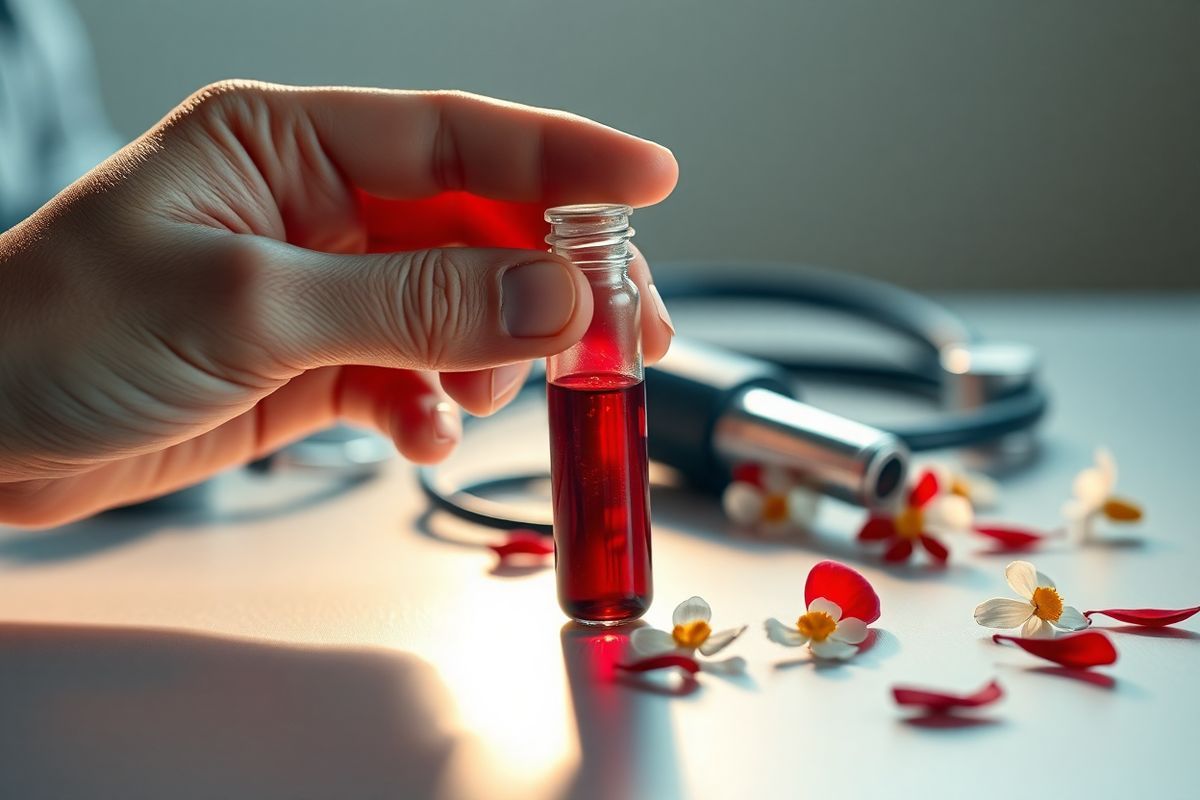Table of Contents
What is Hypercoagulation and How Does it Affect Your Health?

Hypercoagulation, also known as thrombophilia, is a disorder in which the blood clots excessively, increasing the risk of thrombosis—an obstruction of blood vessels due to clot formation. This condition can be inherited or acquired and may lead to serious health complications if left untreated. It is crucial to understand the implications of hypercoagulation on overall health, as it can lead to conditions such as pulmonary embolism, stroke, and myocardial infarction (heart attack) (Healthline, 2024).
Blood clots are primarily composed of platelets and fibrin, which work together to seal injured blood vessels. However, when blood clots form inappropriately—either too frequently or not dissolving as they should—this can lead to various health issues. For instance, when a clot forms in a deep vein (usually in the legs), it can cause DVT, which can subsequently dislodge and travel to the lungs, resulting in a pulmonary embolism (Cleveland Clinic, 2024).
TablCommon Conditions Associated with Hypercoagulation
| Condition | Description |
|---|---|
| Deep Vein Thrombosis (DVT) | Clots form in deep veins, usually in the legs, causing pain and swelling. |
| Pulmonary Embolism | A clot that travels to the lungs, causing shortness of breath and chest pain. |
| Stroke | A clot in the brain that can lead to loss of function or death. |
| Heart Attack | A blockage in the coronary arteries due to clot formation. |
The Mechanisms Behind Hypercoagulation: Causes and Risk Factors
Hypercoagulation can occur due to genetic predispositions or external environmental factors. Understanding these mechanisms is essential for effective diagnosis and treatment.
Genetic Causes
Certain inherited conditions can lead to hypercoagulation, often referred to as inherited thrombophilia. Notable genetic causes include:
- Factor V Leiden Mutation: This is the most common inherited blood clotting disorder, where a mutation in the factor V gene increases the risk of DVT and pulmonary embolism (Cleveland Clinic, 2024).
- Prothrombin Gene Mutation (G20210A): This mutation affects prothrombin levels, increasing the risk of clots (Healthline, 2024).
- Antithrombin Deficiency: Antithrombin is a protein that helps regulate blood clotting. A deficiency can lead to increased clot formation (Healthline, 2024).
- Protein C and S Deficiencies: These proteins function to inhibit clotting; their deficiencies can lead to excessive clotting (Cleveland Clinic, 2024).
Acquired Causes
Acquired hypercoagulation can result from various medical conditions, lifestyle choices, and medications:
- Medical Conditions: Conditions such as cancer, diabetes, obesity, and autoimmune disorders can increase the likelihood of hypercoagulation (Minimally Invasive Surgical Solutions, 2024).
- Medications: Certain medications, including hormone replacement therapies, oral contraceptives, and cancer treatments, can elevate clotting risk (Healthline, 2024).
- Lifestyle Factors: Sedentary behavior, smoking, and prolonged immobility (e.g., long flights) significantly contribute to increased clot formation (Cleveland Clinic, 2024).
TablRisk Factors for Hypercoagulation
| Risk Factor | Description |
|---|---|
| Genetic Mutations | Inherited conditions like Factor V Leiden and Prothrombin G20210A. |
| Medical Conditions | Cancer, diabetes, and obesity increase risk. |
| Medications | Hormonal therapies and certain cancer treatments can elevate clot risk. |
| Lifestyle Factors | Sedentary lifestyle, smoking, and prolonged immobility heighten risk. |
Symptoms of Hypercoagulation: Recognizing the Signs of Blood Clots

Identifying symptoms of hypercoagulation is critical for early intervention. Symptoms can vary depending on the location of the clot:
- In Deep Veins (DVT): Swelling, pain, and tenderness in the affected leg, discoloration, and warmth in the area.
- In Lungs (Pulmonary Embolism): Sudden shortness of breath, chest pain (which may worsen with deep breathing), rapid heart rate, and coughing up blood.
- In the Brain (Stroke): Sudden weakness or numbness (especially on one side of the body), confusion, difficulty speaking, and severe headache (Healthline, 2024).
TablSymptoms of Blood Clots by Location
| Location | Symptoms |
|---|---|
| Deep Veins | Swelling, pain, discoloration, warmth |
| Lungs | Shortness of breath, chest pain, rapid heart rate, cough |
| Brain | Weakness/numbness, confusion, difficulty speaking, severe headache |
Diagnostic Approaches for Hypercoagulation: Tests and Assessments
Diagnosing hypercoagulation involves a combination of patient history, physical examination, and various laboratory tests:
- Physical Examination: A healthcare provider will assess symptoms and perform a physical examination to check for swelling and pain in the limbs.
- Blood Tests: Tests such as complete blood count (CBC), D-dimer, and specific clotting factor tests (e.g., protein C, protein S) help determine clotting tendencies (Cleveland Clinic, 2024).
- Imaging Tests: Ultrasounds can visualize clots in veins, while CT scans are often used for detecting pulmonary embolism (Healthline, 2024).
TablDiagnostic Tests for Hypercoagulation
| Test Type | Purpose |
|---|---|
| Blood Tests | Assess clotting factors, D-dimer levels, and complete blood count. |
| Ultrasound | Visualize clots in deep veins (e.g., legs). |
| CT Scan | Detect pulmonary embolism through imaging of the lungs. |
Treatment and Management of Hypercoagulation: Strategies to Reduce Blood Clot Risks
Management of hypercoagulation focuses on preventing clot formation and treating existing clots. This may involve:
Medications
- Anticoagulants: Medications such as Warfarin, Heparin, and direct oral anticoagulants (DOACs) are commonly prescribed to prevent new clots (Minimally Invasive Surgical Solutions, 2024).
- Aspirin: Low-dose aspirin may be recommended for certain patients to reduce clotting risk (Cleveland Clinic, 2024).
Lifestyle Changes
- Diet: Maintaining a balanced diet rich in fruits, vegetables, and whole grains can support cardiovascular health while limiting foods high in vitamin K if on anticoagulants (Healthline, 2024).
- Physical Activity: Regular exercise can help reduce the risk of clot formation by promoting good circulation (Cleveland Clinic, 2024).
- Hydration: Staying well-hydrated is essential, especially during long periods of immobility (Healthline, 2024).
Monitoring and Follow-Up
Patients on anticoagulant therapy require regular monitoring through blood tests to ensure the effectiveness of treatment and to adjust dosages as necessary (Minimally Invasive Surgical Solutions, 2024).
FAQ
What is hypercoagulation?
Hypercoagulation refers to a condition where blood clots form excessively, increasing the risk of thrombosis.
What are the symptoms of hypercoagulation?
Symptoms can vary based on clot location but may include swelling, pain, shortness of breath, chest pain, and neurological signs like weakness or confusion.
How is hypercoagulation diagnosed?
Diagnosis typically involves a physical examination, blood tests to assess clotting factors, and imaging studies to visualize clots.
What treatments are available for hypercoagulation?
Treatment may include anticoagulant medications, lifestyle modifications, and regular monitoring by healthcare providers.
Can hypercoagulation be prevented?
While inherited forms cannot be prevented, acquired hypercoagulation can often be mitigated through lifestyle changes and medical management.
References
- Healthline. (2024). What Is Hypercoagulation (Thrombophilia)? Retrieved from https://www.healthline.com/health/hypercoagulation
- Cleveland Clinic. (2024). Blood Clotting Disorders: Types, Signs and Treatment. Retrieved from https://my.clevelandclinic.org/health/diseases/16788-blood-clotting-disorders-hypercoagulable-states
- Minimally Invasive Surgical Solutions. (2024). Hypercoagulation Disorders. Retrieved from https://www.endovascularsurgery.com/hypercoagulation-disorders.php











